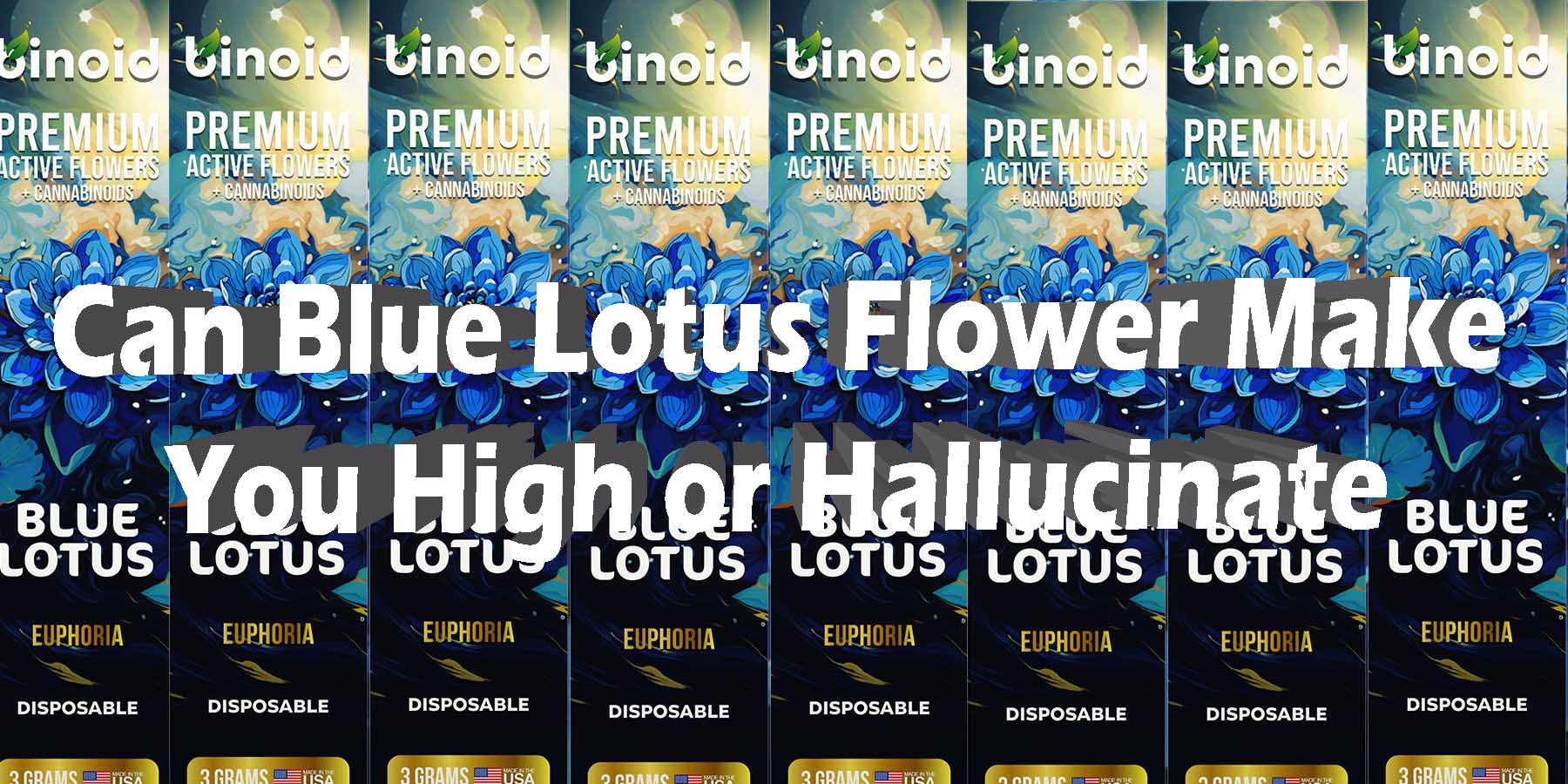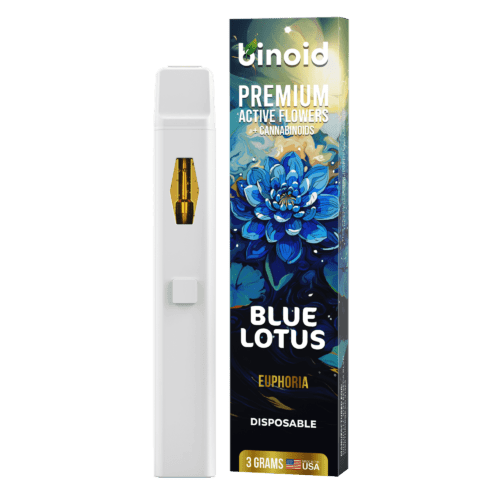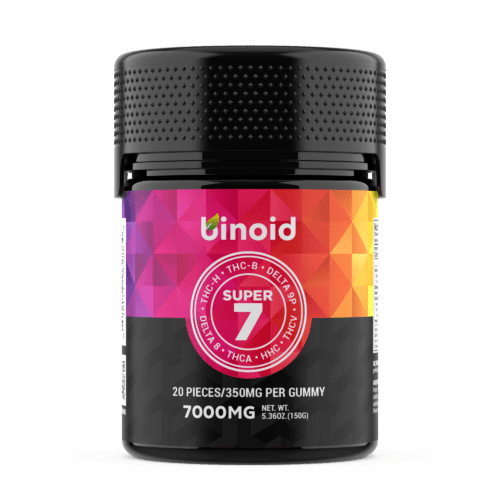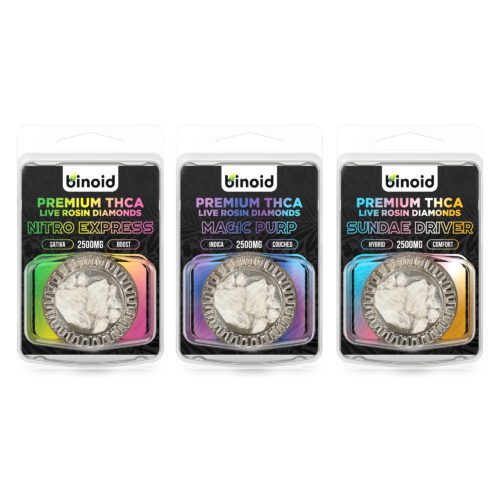
Does Blue Lotus Flower Make You Hallucinate or High?
The blue lotus (Nymphaea caerulea) flower is a water lily that grows in Egypt and parts of Africa. It’s known for its psychoactive properties, and historical records indicate it was used by ancient Egyptian priests and nobles as part of religious ceremonies and rituals, capable of bringing one closer to the gods. The primary compounds in blue lotus that are believed to contribute to its effects are nuciferine and aporphine, more on those a bit later on here.
Now, since blue lotus was used traditionally as an aphrodisiac, mild intoxicant, and even a medicine, it may offer feelings of euphoria and inner peace simultaneously, while creating a cerebral buzz that’s not as intense as cannabis. So, that brings us to the question on many users’ minds then, “can blue lotus flower actually make you high or cause hallucinations to occur?”
To Buy Blue Lotus Flowers Vape Click Here
-
Product on sale
 Active Flowers 3 Gram Disposable$35.99
Active Flowers 3 Gram Disposable$35.99$69.99
Understanding Blue Lotus Chemistry
Chemical analysis of the blue lotus displays the plant housing more than 20 unique antioxidants including phenols, flavonoids, saponins, anthraquinones and anthocyanins. These are present in all parts of the plant, with the highest concentrations in the leaves and the flowers. Most impressively, the blue lotus contains the two alkaloids:
- Nuciferine: This is an alkaloid found in blue lotus, and it’s one of the more well-studied components. Nuciferine is known to act as a dopamine receptor blocker, which means it can interfere with the action of dopamine in the brain. Dopamine is a neurotransmitter that plays a significant role in reward, motivation, memory, and attention. By blocking its effects, nuciferine might induce sedative effects, although the specifics of how it affects human perception and mood are still not thoroughly understood.
- Apomorphine: This is another compound found in blue lotus, though in very minute quantities. Apomorphine has been known for its potential dopamine agonist effects, meaning it can stimulate dopamine receptors. This is the opposite action of nuciferine. In medical settings, apomorphine is used for its emetic properties (inducing vomiting) and in the treatment of Parkinson’s disease (due to its ability to stimulate dopamine receptors). However, the trace amounts in Blue Lotus are likely not significant enough to achieve these clinical effects.
Basically, these effects from each alkaloid can include a sense of relaxation and euphoria, along with a distorted sense of time, a heightened sensitivity to light and colors, and more sociability. However, the intensity and particular nature of these effects can vary widely among individuals based on variables such as individual body chemistry, the specific preparation and quantity of blue lotus consumed, and the simultaneous use of other substances.
What are Blue Lotus Flower’s Psychoactive Effects and Can It Get Me High?
Though blue lotus isn’t as potent as some other substances, many users report a range of psychoactive effects. It is important to keep in mind that experiences with psychoactive substances can vary significantly from person to person based on factors such as individual sensitivity, dosage, and the specific context in which the substance is used.
With that said, here are some of the effects often attributed to Blue Lotus:
- Mild Sedation: Blue Lotus has natural compounds that can provide a sedative effect. It’s often used to alleviate anxiety, provide a sense of calm, and even help with insomnia. It doesn’t typically induce a strong sedative effect like pharmaceutical sedatives do, but many users report a noticeable relaxation and easing of tension.
- Euphoria: Some users experience mild euphoria, or a sense of increased well-being and happiness. This isn’t usually a “high” in the sense that someone might experience with, let’s say, more potent substances; it’s often described as a gentle, pleasant uplift in mood.
- Altered Perception: There are reports of Blue Lotus having mild psychoactive properties, which can include slight changes in perceptual experiences. This can manifest as subtle visual or auditory alterations, though not to the extent of hallucinations that one might experience with stronger psychedelics.
- Enhanced Socialization: In some cases, people have reported that Blue Lotus makes socializing easier and more enjoyable. They find themselves more comfortable in social settings, feeling more open, and communicative.
- Sexual Enhancement: Historically, Blue Lotus has been used as an aphrodisiac. Some people continue to use it for its ability to enhance sexual experiences, though these effects can be quite subtle and are not universally experienced.
Are There Any Risks of Using Blue Lotus Flower?
As we discussed, blue lotus flower contains bioactive compounds such as nuciferine and aporphine, which are known to have psychoactive effects—though these effects can be subtle and don’t typically induce hallucinations like those associated with stronger psychedelics such as LSD or psilocybin. Still, just like any other substance, frequent use can lead to tolerance build-up, requiring higher doses for those said identical effects.
Now, even though the blue lotus flower is advertised to improve mental health, it can cause euphoria, hallucinations – more on that in second, and emergency room visits at higher doses. Case studies reported altered mental status, agitation, anxiety, chest pain, and tachycardia.
So, in addition to the health risks, there is also the chance of unforeseeable reactions that might catch you off guard. Lotus addiction isn’t just about physical symptoms, it can lead to unexpected side effects like lotus hallucinations. These aren’t your everyday dreams; they’re vivid and surreal experiences that can leave you disoriented. You could see things that aren’t there or feel sensations without apparent cause.
Again though, these experiences are highly subjective and can depend on numerous factors, including the dosage, the individual’s body chemistry, and the method of consumption.
-
Product on sale
 Super 7 Gummies – 7000MG$39.97
Super 7 Gummies – 7000MG$39.97$59.99
What About Usage in Terms of Effects?
Today, people have used blue lotus extracts, teas, and concentrates or tinctures for either relaxation, as a sleep aid, or for mild stress relief. Blue lotus is sometimes used in aromatherapy or as a smoking/vaping blend ingredient.
The ‘high’ described is generally quite subtle and doesn’t compare to the effects of stronger psychoactive substances. So, yes, the method of consumption affects the intensity and duration of the effects.
Final Thoughts
As you can see, it seems as though blue lotus does have the ability to get one ‘high’. However, you need to remember that much of the evidence supporting the use of blue lotus is anecdotal, and there are limited scientific studies on its effects on humans. And, due to the lack of comprehensive studies on blue lotus, there could be potential side effects or interactions with medications that are not yet known.
Always use caution and, if possible, consult with a healthcare professional before using natural remedies like blue lotus. Overdose might cause mild hallucinations or nausea to happen, take notice of that. Also, make sure though to buy blue lotus from a reputable source in order to avoid either fake blue lotus flower or overly modified blue lotus.
To Buy Blue Lotus Flowers Vape Click Here
-
Product on sale
 THCA Diamonds 2500mg – Bundle$102.99
THCA Diamonds 2500mg – Bundle$102.99$169.99



